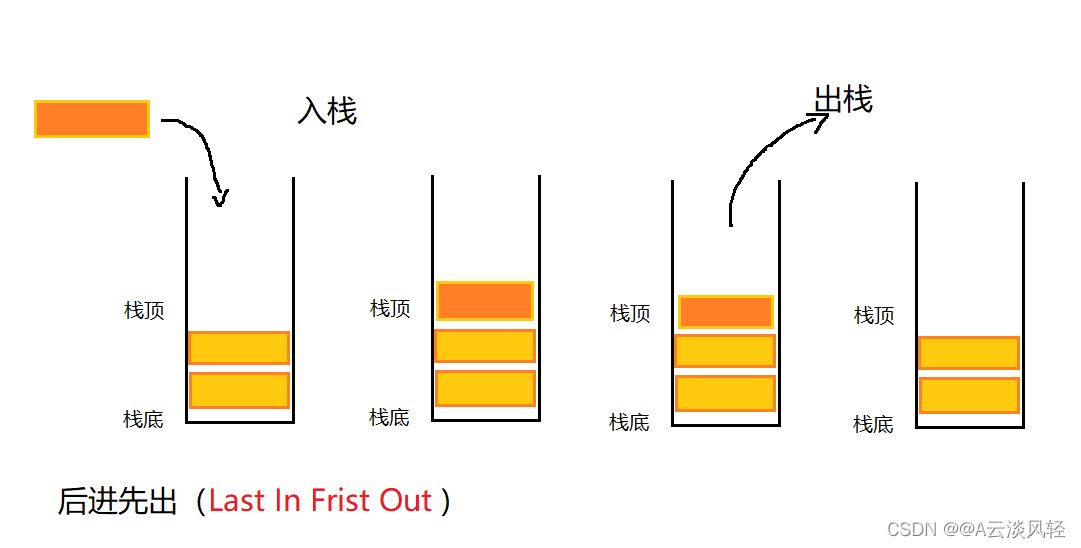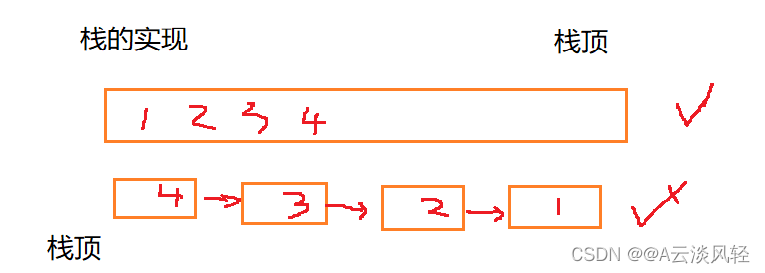1.栈的概念及结构
栈:一种特殊的线性表,其只允许在固定的一端进行插入和删除元素操作。进行数据插入和删除操作的一端称为栈顶,另一端称为栈底。栈中的元素遵循**后进先出LIFO(Last in First Out)**的原则。
压栈:栈的插入操作叫做进栈/压栈/入栈。入数据在栈顶。
出栈:栈的删除操作叫做出栈。出数据在栈顶。

接下来让我们实现一个栈,首先我们需要想,栈的实现用数组好还是链表好呢?
答案是数组较好一些。
由于栈的操作只在栈顶进行,对于尾插尾删等,数组的效率更好一些,链表的尾插尾删要找尾和尾的前一个,效率较低,如果实在想用链表可以用链表的头插,链表的头插头删效率还不错。

2.栈的结构体部分
动态数组
这里的top从0开始,标识尾的下一个。
typedef int STDataType;
typedef struct Stack
{
STDataType* a;
int top;
int capacity;
}ST;
3.栈的初始化
这里会改变结构体,所以传结构体的地址,即用一级指针传参。
void StackInit(ST* ps)
{
assert(ps);
ps->a = NULL;
ps->top = ps->capacity = 0;
}
4.栈的销毁
void StackDestory(ST* ps)
{
assert(ps);
free(ps->a);
ps->a = NULL;
ps->top = ps->capacity = 0;
}
5.入栈
void StackPush(ST* ps, STDataType x)
{
assert(ps);
if (ps->top == ps->capacity) //空间不够就增容
{
int newCapacity = ps->capacity == 0 ? 4 : (ps->capacity) * 2;
STDataType* tmp = (STDataType*)realloc(ps->a, sizeof(STDataType)*newCapacity);
if (tmp == NULL)
{
printf("realloc fail\n");
exit(-1);
}
ps->a = tmp;
ps->capacity = newCapacity;
}
ps->a[ps->top] = x;
ps->top++;
}
6.出栈
void StackPop(ST* ps)
{
assert(ps);
assert(!StackEmpty(ps));
ps->top--;
}
7.取栈顶元素
STDataType StackTop(ST* ps)
{
assert(ps);
assert(!StackEmpty(ps));
return ps->a[ps->top - 1];
}
8.判断栈是否为空
bool StackEmpty(ST* ps)
{
assert(ps);
return ps->top == 0;
}
9.栈的大小
int StackSize(ST* ps)
{
assert(ps);
return ps->top;
}
10.总的函数接口代码
void StackInit(ST* ps)
{
assert(ps);
ps->a = NULL;
ps->top = ps->capacity = 0;
}
void StackDestory(ST* ps)
{
assert(ps);
free(ps->a);
ps->a = NULL;
ps->top = ps->capacity = 0;
}
void StackPush(ST* ps, STDataType x)
{
assert(ps);
if (ps->top == ps->capacity)
{
int newCapacity = ps->capacity == 0 ? 4 : (ps->capacity) * 2;
STDataType* tmp = (STDataType*)realloc(ps->a, sizeof(STDataType)*newCapacity);
if (tmp == NULL)
{
printf("realloc fail\n");
exit(-1);
}
ps->a = tmp;
ps->capacity = newCapacity;
}
ps->a[ps->top] = x;
ps->top++;
}
void StackPop(ST* ps)
{
assert(ps);
assert(!StackEmpty(ps));
ps->top--;
}
STDataType StackTop(ST* ps)
{
assert(ps);
assert(!StackEmpty(ps));
return ps->a[ps->top - 1];
}
bool StackEmpty(ST* ps)
{
assert(ps);
return ps->top == 0;
}
int StackSize(ST* ps)
{
assert(ps);
return ps->top;
}
如果对您有所帮助,期待您的点赞和关注呀😍!
如果有不明白的地方可以私信我,很乐意为您解答😉👍。






















 4044
4044











 被折叠的 条评论
为什么被折叠?
被折叠的 条评论
为什么被折叠?








